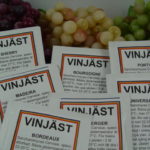 Bordeaux
Bordeaux
Na świecie jest naprawdę wiele regionów winiarskich, ale może ze dwa lub trzy mogą poszczycić się taką marką jak francuski Bordeaux. Od razu spieszę z wyjaśnieniem, że owszem, nazwa ta ma wiele wspólnego z kolorem bordo, a w zasadzie kolorem bordeaux. Koloru bordowego natomiast nie ma, ponieważ wino jest bordoskie, a nie bordowe, nawet jeśli ma kolor bordo.
Tak czy owak, Bordeaux to ojczyzna najbardziej znanych, najbardziej prestiżowych marek wina, które powstaje w mniej więcej dziewięciu tysiącach winnic i każdego roku zamykane jest w prawie siedmiuset milionach butelek. Oczywiście nie wszystkie z nich to najlepsze roczniki najznakomitszych etykiet, ale także doskonałe wina stołowe. Żaden inny region nie może poszczycić się takim bogactwem smaków i aromatów wina. Oryginalne wina bordoskie powstają w winnicach zwanych chateaux, czyli z francuska zamkami. Dawniej rzeczywiście każda winnica miała swój zameczek lub chociaż pałacyk, ale dziś już tak nie jest.
Bordeaux to doskonałe miejsce do uprawy winorośli. Klimat jest tutaj łagodny, zimy nigdy nie bywają ostre, każdego roku spada mniej więcej tyle samo deszczu, a cały teren jest równinny, nawodniony wodami rzek Dordogne i Garonny. Rzeki te dzielą Bordeaux na trzy regiony, Lewy Brzeg, Prawy Brzeg i Międzymorze, z których każdy słynie z nieco innych win, ale wszędzie winnice są głównym elementem krajobrazu i zajmują około stu dwudziestu tysięcy hektarów.
Pierwsze wino z bordoskich winnic uzyskali Rzymianie, znani ze swojego zamiłowania do trunku z winnych gron. Jednak to nie im Bordeaux zawdzięcza swoją sławę, ale Anglikom, którzy kilkaset lat później rozciągnęli swoją władzę nad tym rejonem i rozpoczęli eksport wina na szeroką skalę, niemal niespotykaną wcześniej w historii, a która była jedynie skromnym początkiem tego, co dzieje się dziś. W 1855 roku w produkcję wina wmieszał się niejaki Napoleon Bonaparte, znany większości raczej z zamiłowania do wojaczki i tworzenia krótkotrwałych tworów państwowych, a miłośnikom win z tego, że jako pierwszy zainicjował tworzenie klasyfikacji win bordoskich. Wtedy jednak klasyfikacja ta była zdecydowanie prostsza niż dziś, ponieważ o pozycji danego gatunku stanowiły statystyki sprzedaży i dochody uzyskiwane przez producentów. Choć obecnie klasyfikacja oparta jest o zupełnie inne czynniki, nadal stosuje się zaproponowany wówczas podział winnic na pięć cru.
W praktyce wina z Bordeaux nie są bezkonkurencyjne. Równie smaczne, a czasem nawet i smaczniejsze, są wina z innych rejonów Francji, a także z Włoch, Chile czy Portugalii. Tradycja jednak zobowiązuje i to właśnie bordoskie wina są najdroższe i najbardziej poszukiwane. Kiedy jednak się takie znajdzie, wcale niełatwo jest odczytać, co to za trunek wpadł w nasze ręce. Opisy na etykietach win bordoskich uwzględniają zawsze przynależność do jednej z 57 apelacji (AC Bordeaux lub AC Bordeaux Supérieur to tylko dwie najpopularniejsze z nich), ale wina z obu Brzegów i Międzymorza klasyfikowane są także według wewnętrznych oznaczeń winnic. Co więcej, niektóre z klasyfikacji są zawieszane (głównie ze względów prawnych), a inne, choć co do zasady funkcjonują, są przebudowywane, odświeżane lub zmieniane co parę lat, a w przypadku niektórych jest to wręcz tradycją (tak jest w apelacjach St-Émilion i St-Émilion Grand Cru, które swoją klasyfikację odnawiają co dekadę).
Niezależnie jednak od podziałów, jakie są zapisywane na etykietach, wina bordoskie łączy fakt, że zdecydowana większość z nich to w rzeczywistości kupaże z odmian takich jak cabernet sauvignon, merlot, cabernet franc, malbec i petit verdot (to odmiany czerwone, najbardziej znane i odpowiedzialne właśnie za barwę tutejszego wina) oraz sémillon, sauvignon blanc i muscadelle, które są odmianami białymi, służącymi przede wszystkim do wyrobu win słodkich.







